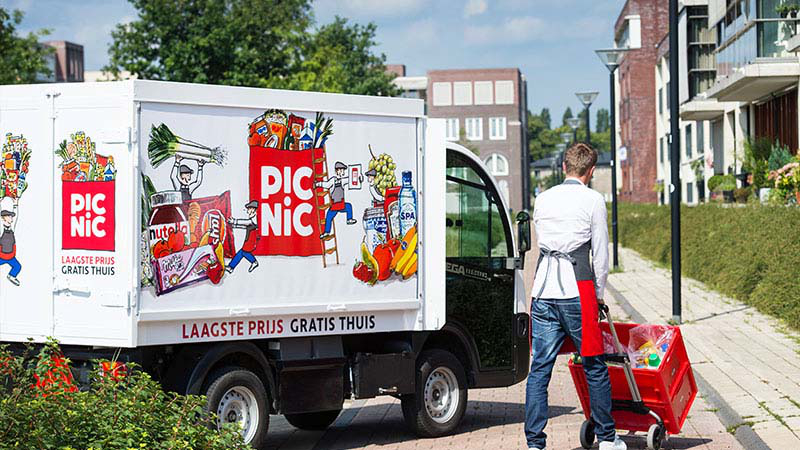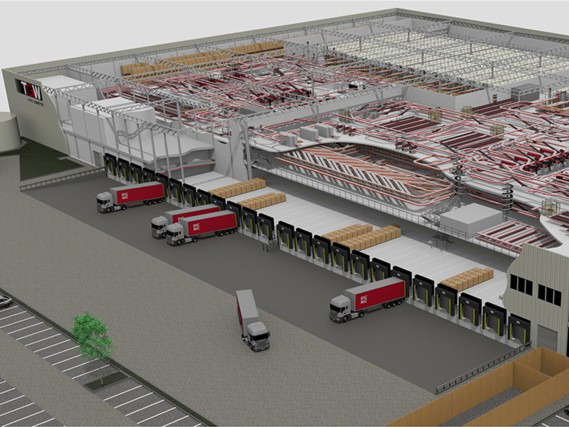- Expert talk on eGrocery
- Frederik Nieuwenhuys, co-founder and managing director of Picnic
- David Hibbett, CEO TGW Northern Europe
(Marchtrenk, December 14, 2020) The expert talk on eGrocery with Frederik Nieuwenhuys, co-founder and managing director of Picnic and David Hibbett, CEO TGW Northern Europe, shows: An intralogistics supplier and a retailer can achieve great results, when both parties are open to collaborate, learn and act together as one team.
What drove you to enter the eGrocery business in 2015?
Frederik Nieuwenhuys: We wanted to become a kind of shop keeper in a certain field. After a short analysis of areas like books and shoes we stumbled over online food and asked ourselves: Why is that business so small whereas the online non-food business is about ten percent of the entire retail business across Europe? After a couple of years of research we came up with a proposition: Let us abolish the three key reasons why people do not buy food online.
What are the three reasons?
Frederik Nieuwenhuys: Firstly, consumers did not want to pay a delivery fee – we took that away. Secondly, they did not want to wait for a delivery a couple of hours at home – we reduced the delivery window to 20 minutes. And finally the ordering process was complicated – we made that easy in an app-only world, without a website. That in combination with our famous milk run model has led to a consumer proposition that is mass market ready. All that plus a highly efficient operating model has finally brought us to where we are now.
Did you want to be disruptive with your business in the very beginning?
Frederik Nieuwenhuys: The first line in our business plan was not: Be disruptive! The first line was the question: How can we create a proposition and operation model that works for consumers – and how will they massively adopt our offer? Today we find cities where 50 percent of the population use our app – that is massive. That was on the one hand. On the other hand we had to find ways to be efficient and have an economic operation model. Our milk run, our last mile model, has enabled that as well as highly efficient warehouse operations. We also thought that we had to automate large parts of that operations.
Have you been afraid of the giants that surrounded you in the market?
Frederik Nieuwenhuys: No, the offline market is dominated by giants. And there are large economies of scale in this business. So we had to work our way around all these economies of scale. We carefully thought that through and included that in our roll out plans in multiple countries.

When have you started to think about automation?
Frederik Nieuwenhuys: That was three years before we started Picnic in 2015. I began to visit sites and talk to suppliers. As we hardly had any experience in automation, we had to build that knowledge.
Why have you chosen to invest in a Central Fulfillment Center, CFC, instead of several Micro Fulfillment Centers, MFCs?
Frederik Nieuwenhuys: There is a tendency in Europe to build CFCs. In the USA, the focus has been on MFCs. We decided to invest in a CFC, because we saw a few challenges to run the MFCs successfully. Of course, many of the traditional retailers with stores have space to add an MFC to a store. Then they have access to stock there. But you have to consider the costs to stock up these MFCs, because then you pass the store-based supply chain. The CFCs on the other hand are sized in such a way that you can manage direct deliveries from a large amount of suppliers to that place. As a result, the inbound costs are very low. Our customers can order today for tomorrow. Therefore, we can precisely predict the number of orders we will get as well as the composition of the orders, enabling us to exactly plan the supply chain and the operations. That makes a big difference to demand-based MFCs.
What makes you proud, that Picnic has chosen TGW as a partner?
David Hibbett: eGrocery is a dynamic and fast changing environment. For the right partnership, you have to ask yourself: What are our core capabilities and what are their capabilities – and do they fit? Basically, TGW and Picnic are two technology companies. TGW is a technology company that comes from the hardware of automation. The company knows how to move goods within a warehouse efficiently. Picnic on the other hand understands ordering systems, supply chain and the operating area of a warehouse. The company also has a unique proposition in service offerings. Additionally, the cultures align. Picnic has an interesting mindset: Everything can be developed, changed and challenged. For the people inside TGW that is a great environment to be working with.
Frederik Nieuwenhuys: That describes us nicely. This is our first big automation project and we do not bring a lot of experience to the table. But we have some great brains with a lot of energy and perseverance. All in all, the cooperation that we have built is quite unique for Picnic and I also think for TGW. That is a good foundation for the project. And the start has been really positive. An important factor for success in such a complex project is also the level of transparency. And we have brought a high level of transparency into the two teams. Every day we ask each other a lot of questions, which is great. I learned that from Jeff Bezos, who said: We are not a ‘we-know-it-all-company’ but we are a ‘we-learn-it-all-company’.

How does the fulfillment of a customer’s order work?
Frederik Nieuwenhuys: The customers can place orders until a certain cut-off time. Days and weeks before that, we forecasted the number of orders and consumers. We also forecasted what we are likely to sell – how many cucumbers or bottles of milk etc. All that results in inbound forecasts and orders for the suppliers. We need to make sure to have the right quantities in the warehouse. Picnic needs an order completeness of 99 percent plus but also a low level of waste. The level of waste is about 70 percent lower than the level in stores. Once we have received the orders, we allocate them to totes. As soon as we know how many totes we have for an order, we perform our famous trip planning for a milk run. That is probably the most efficient system in the world. Then we decide which orders are in which trip and which trip is leaving at what time with which driver and many more aspects. Moreover, we know when these orders have to leave the warehouse. It is what drives the heartbeat in the warehouse: The question is: Which orders are processed first and which next. That is a challenge because customers can change their orders until just before the order is processed.

David Hibbett: The request from Picnic meant for TGW: The system needs to be super-fast, super-flexible and you always have to have the sequencing in your mind. The shuttle system is the central engine in the warehouse. In and around that, we have designed many peripheral systems. Basically, we have two picking systems. One is for large, light and fragile items, which we want to protect. There is a person-to-goods-system for these items. The rest of the items go to our picking stations. All the items together then go back into the system to be consolidated. At the right release time, they are transferred to the order area to meet the Picnic sequencing for the planning of the routes.
What are the challenges in the e-commerce business?
David Hibbett: Basically, the automation industry as well as companies such as Picnic face two challenges: The rate of change and the rate of growth. But the biggest challenge is the reskilling of individuals into our market, though. Automation requires brilliant engineers and IT experts. There is a high demand already.
Frederik Nieuwenhuys: We can hire talented people from university, who can learn fast. But they need a bit of time to learn about automated fulfillment centers. This is our first big automation project – and we plan numerous others outside the Netherlands as well. And for those projects, we need to standardise software, modules, reporting and maintenance in such a way that we can reliably operate a significant number of fulfillment centers in a similar way.
Does Picnic's business model have to change in the future?
Frederik Nieuwenhuys: The core of the business model is very solid. We are in a mass market. I think our business model has a lot of add-on potential. We have started to process return parcels, we could also do them outbound. When we think about warehouse automation, we also take these processes into account.




